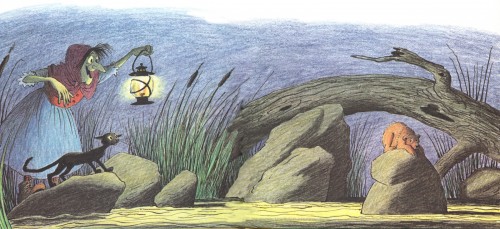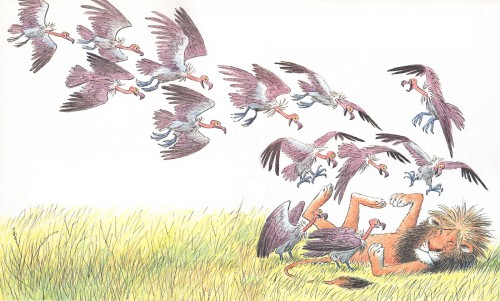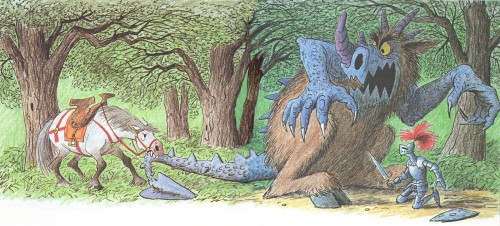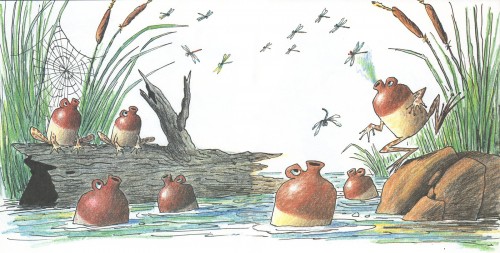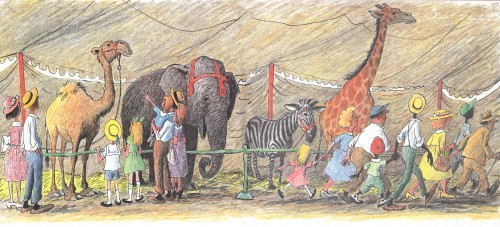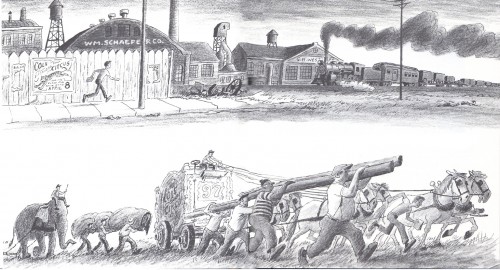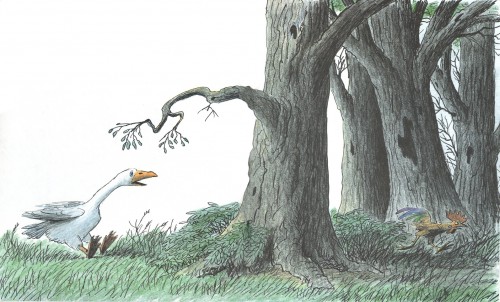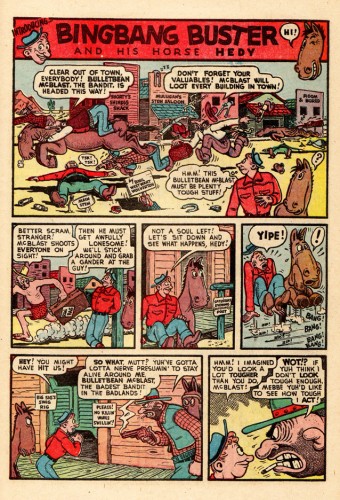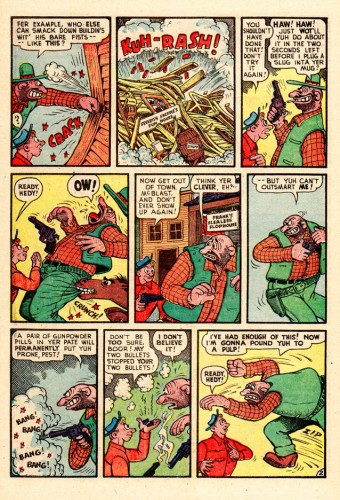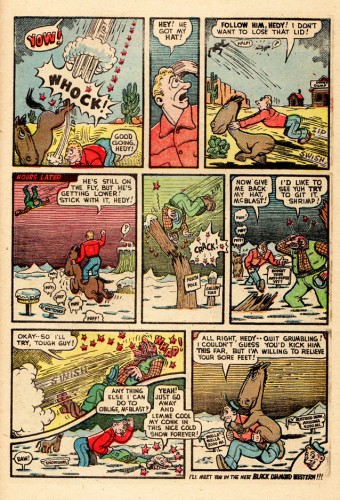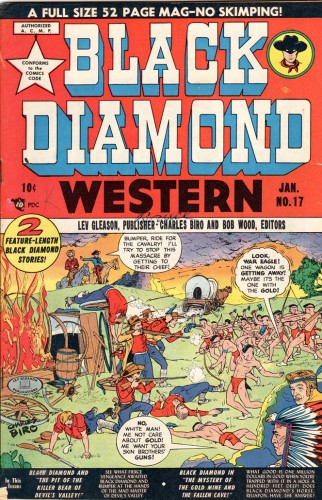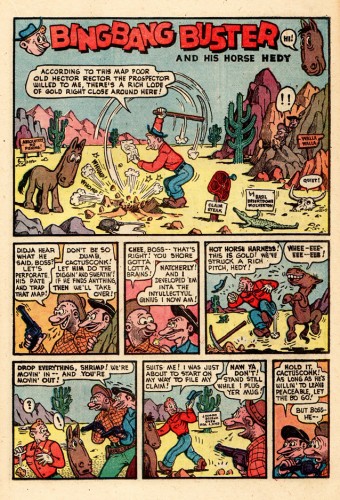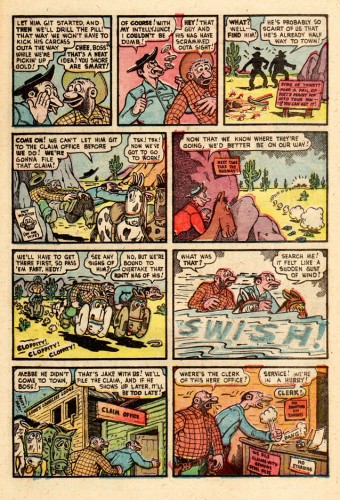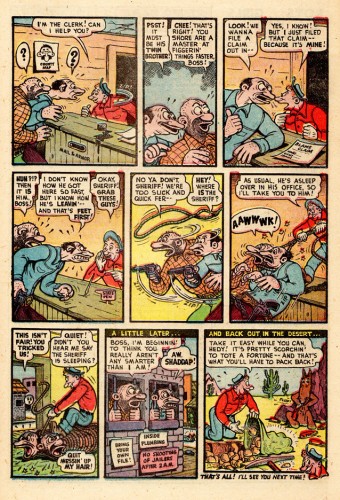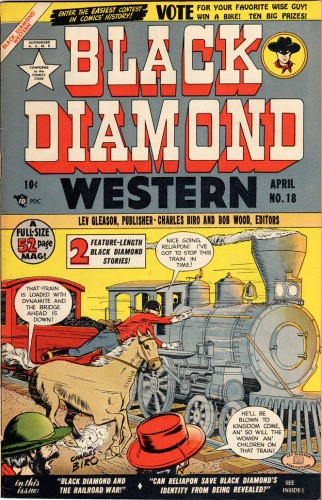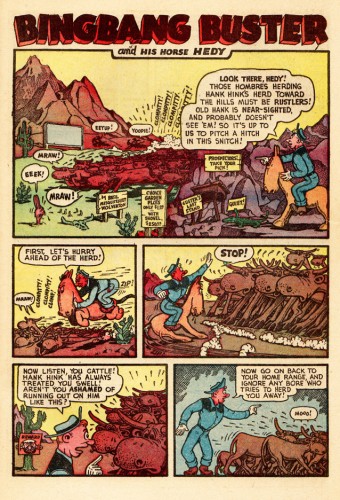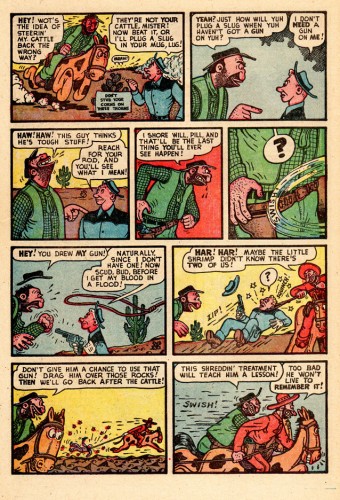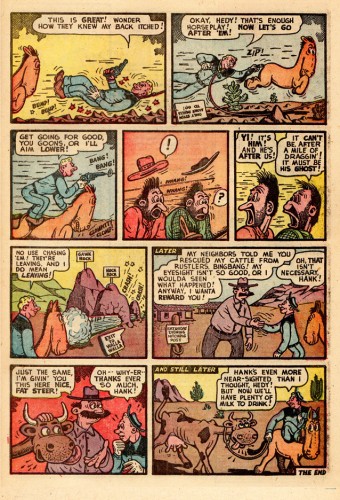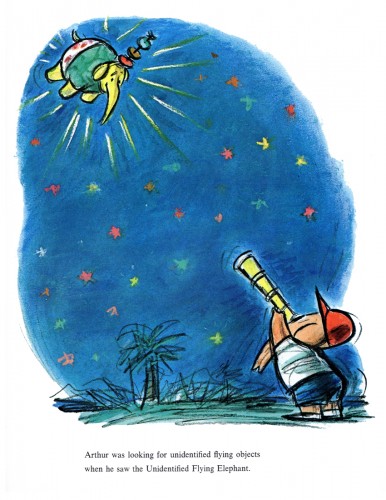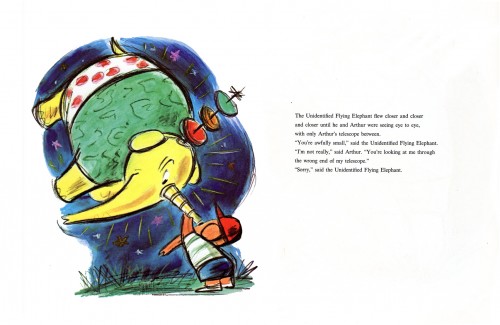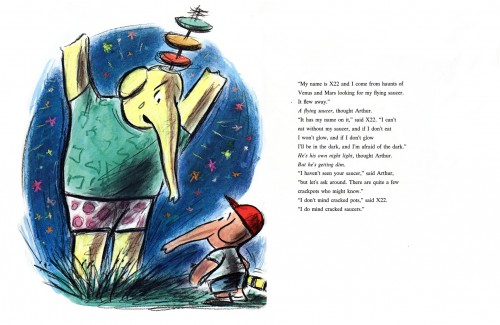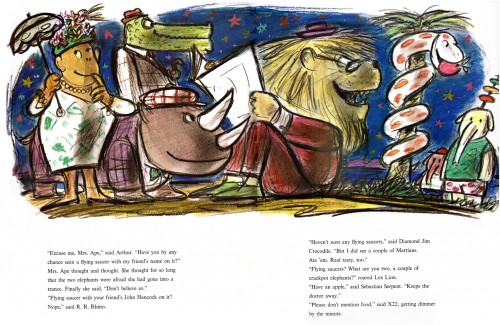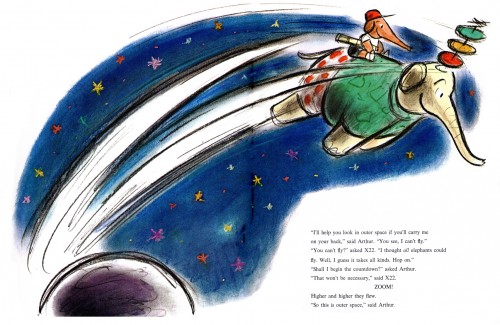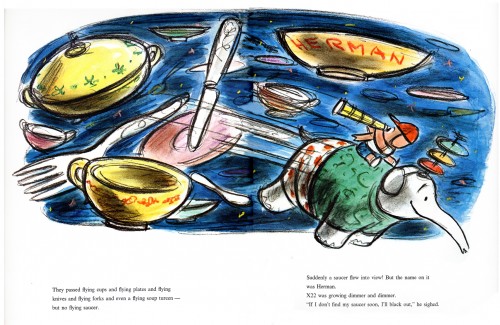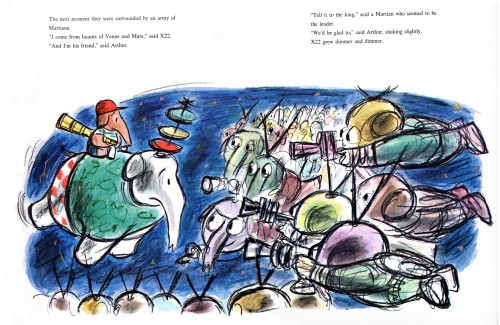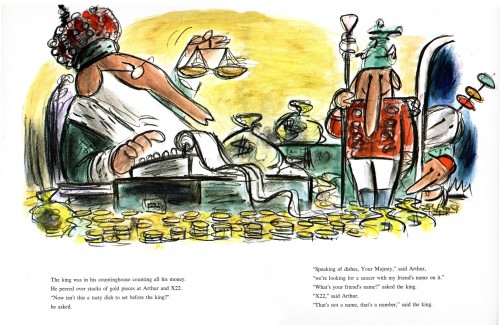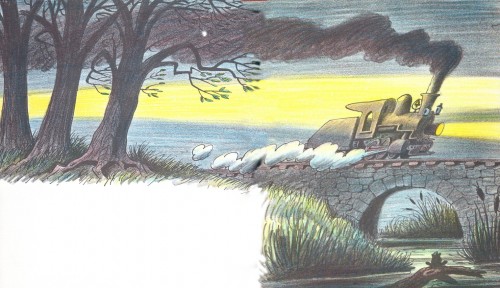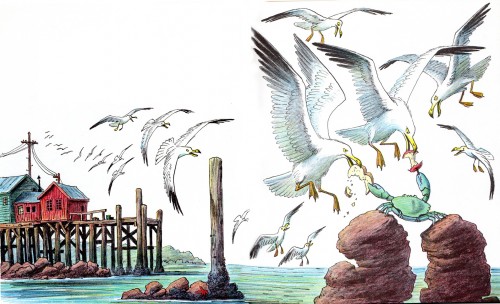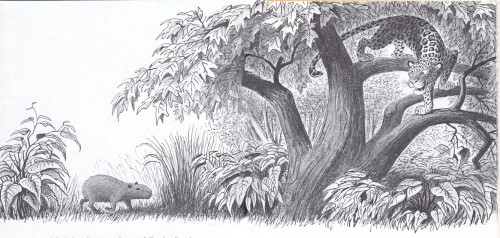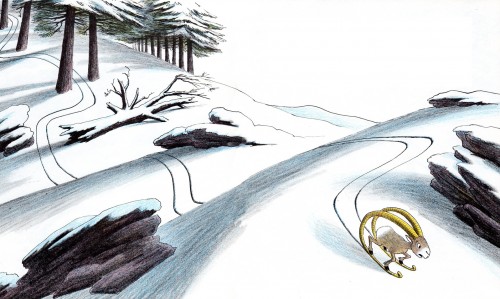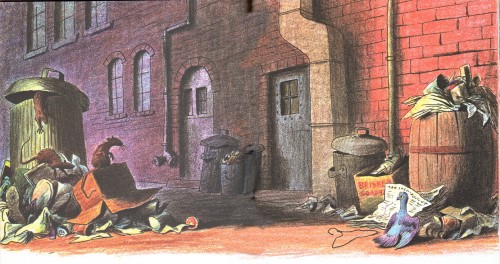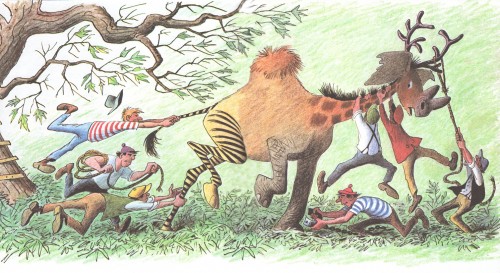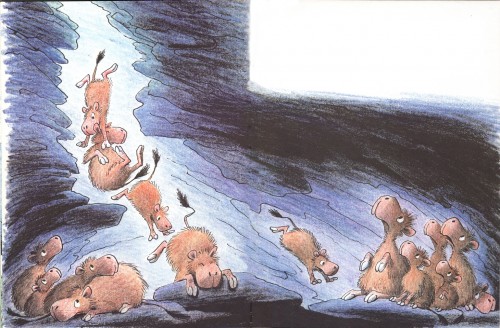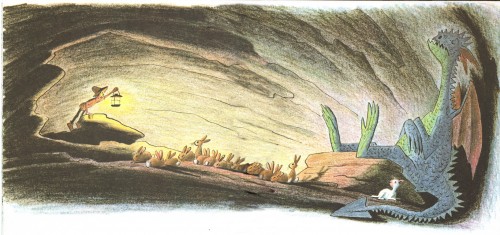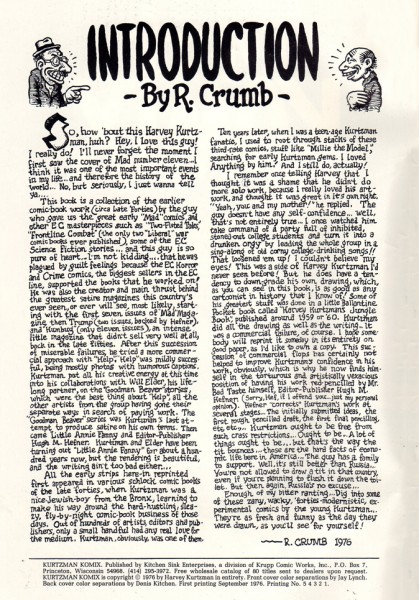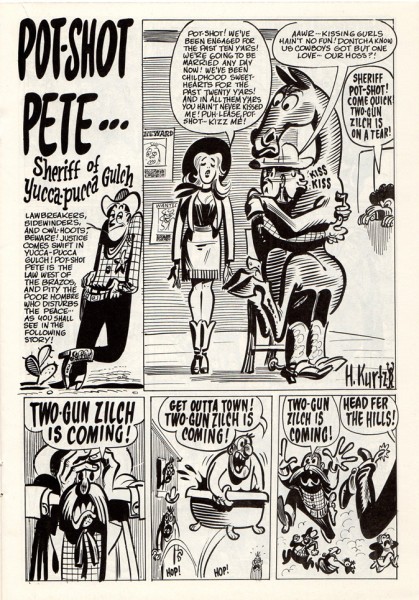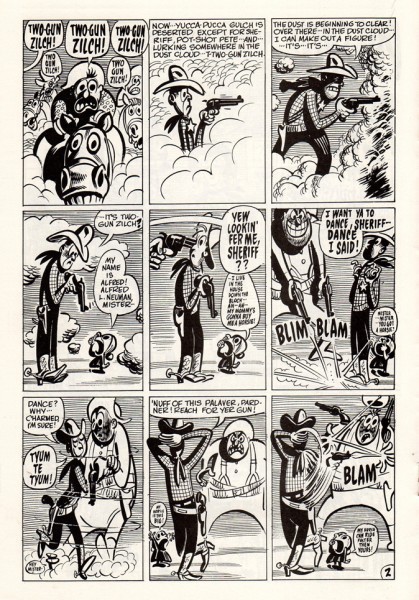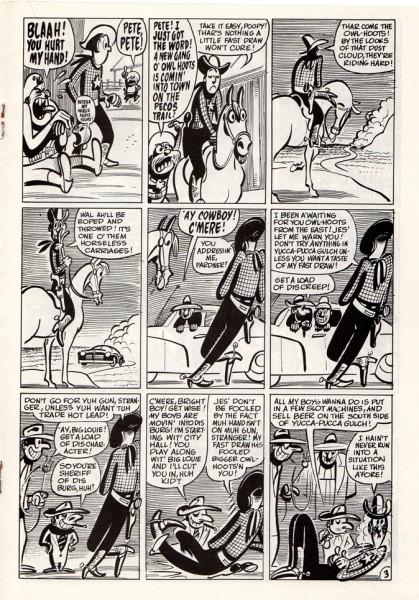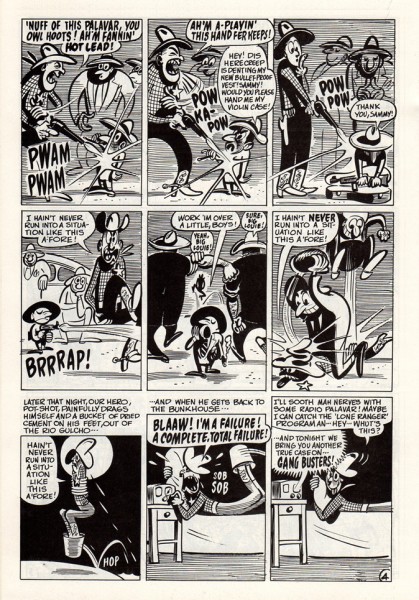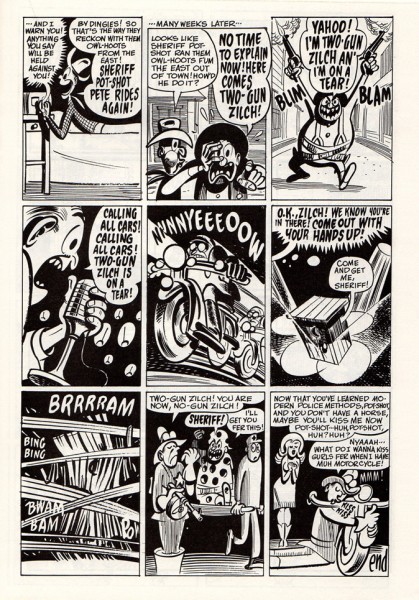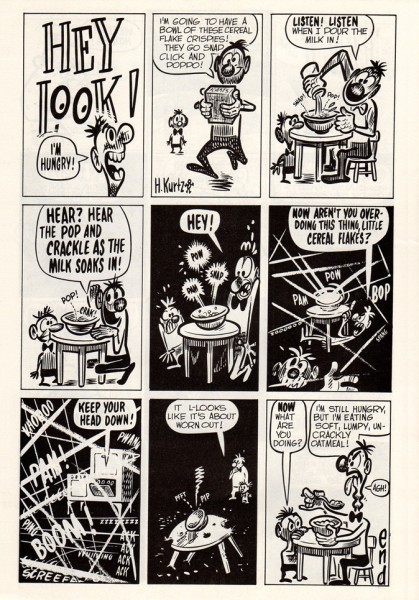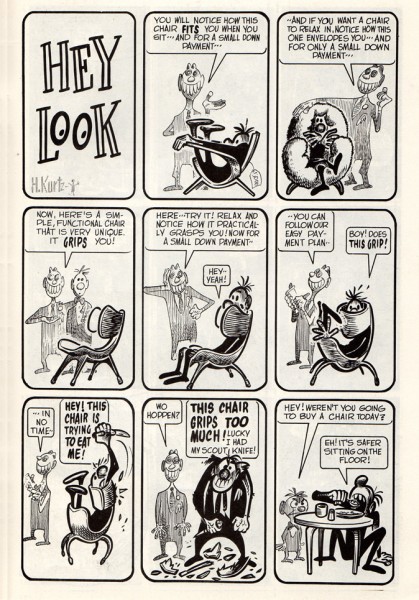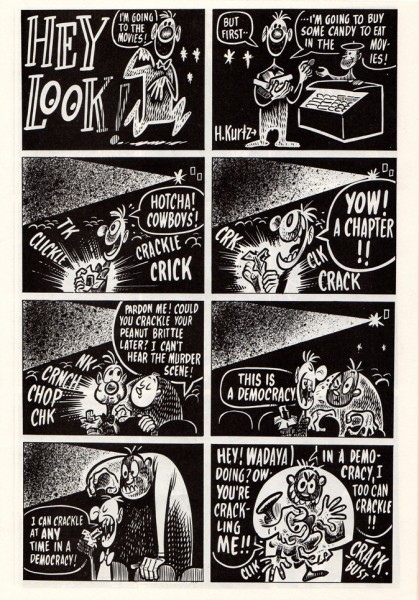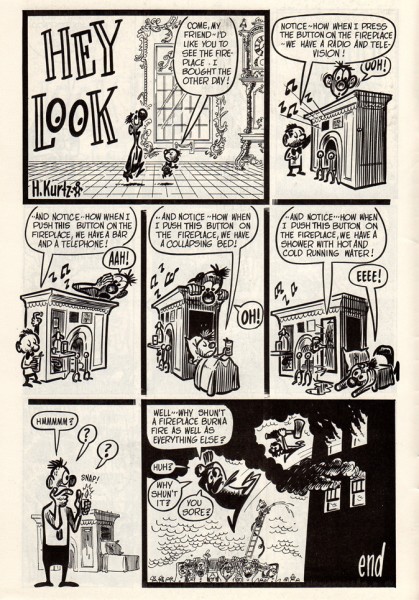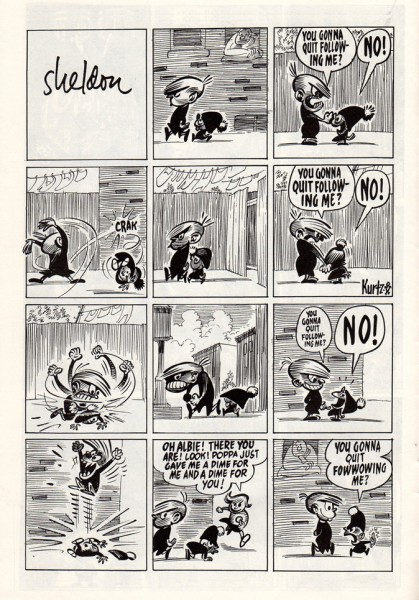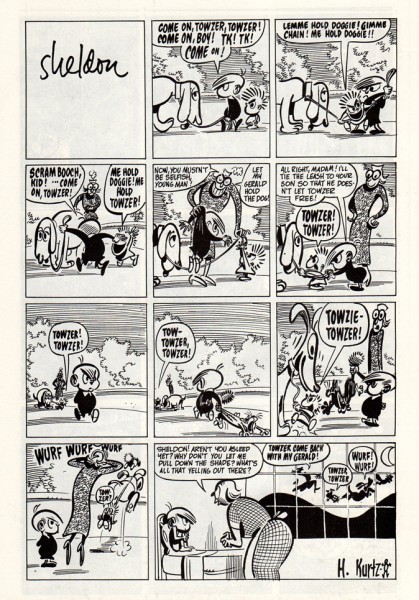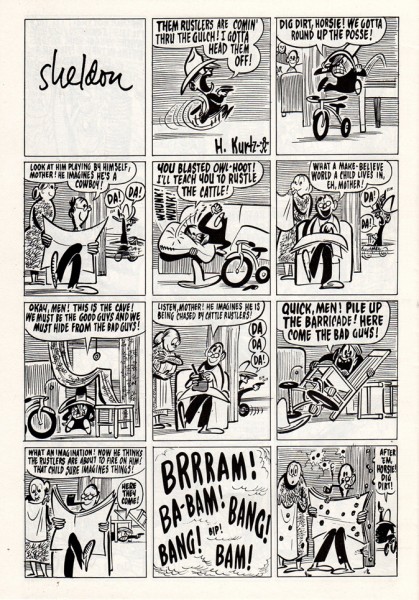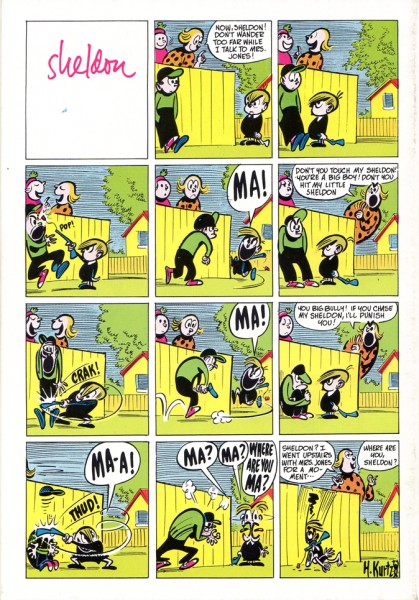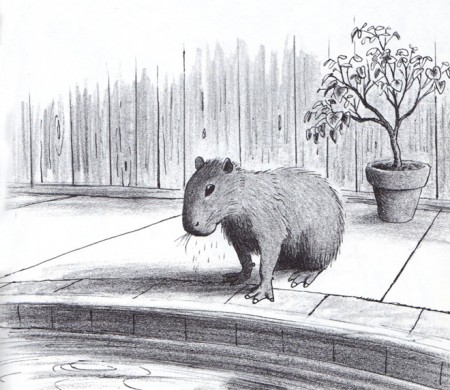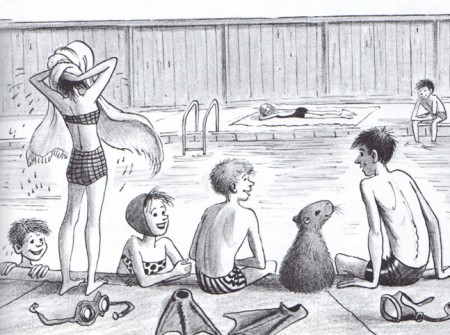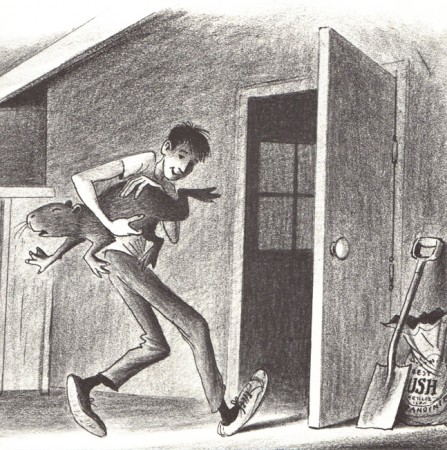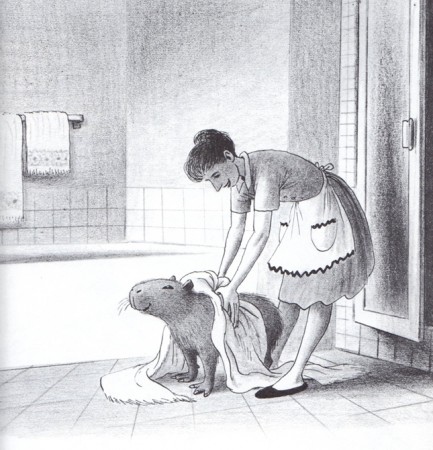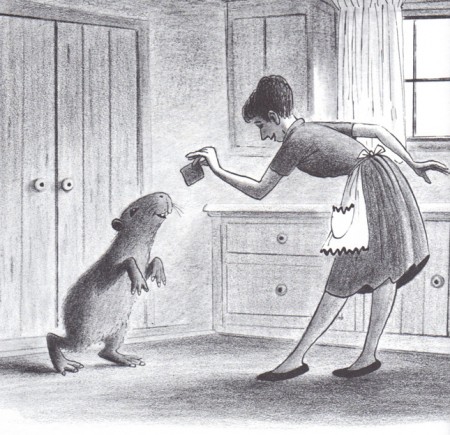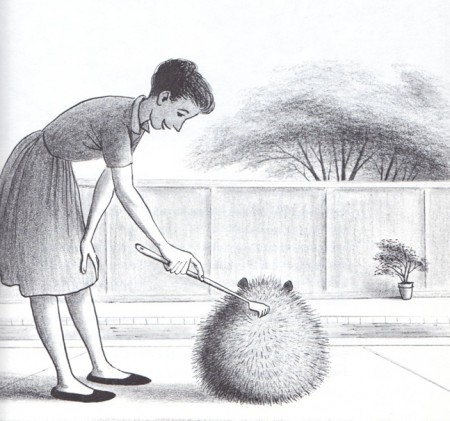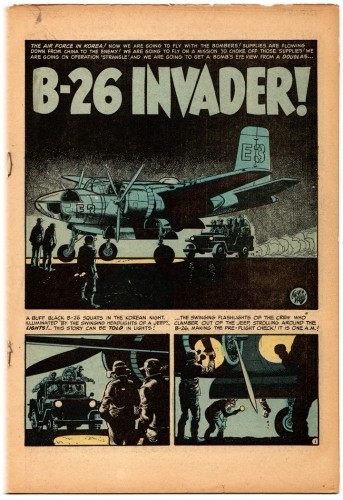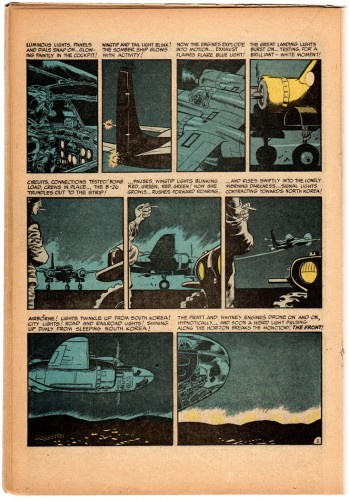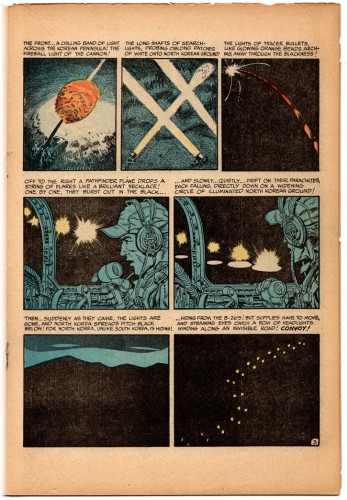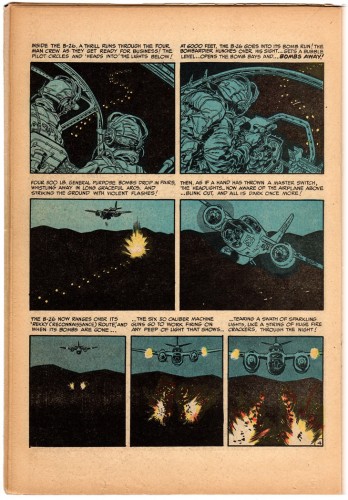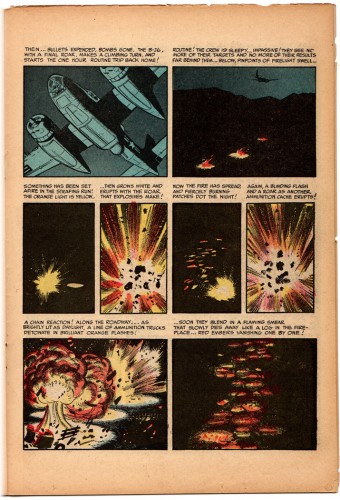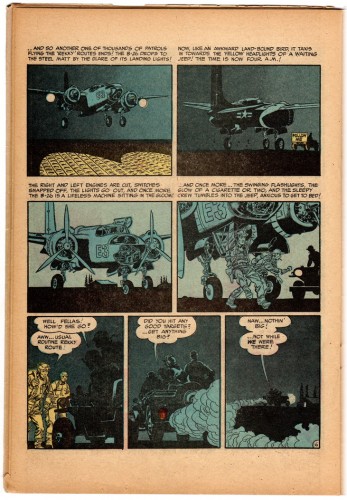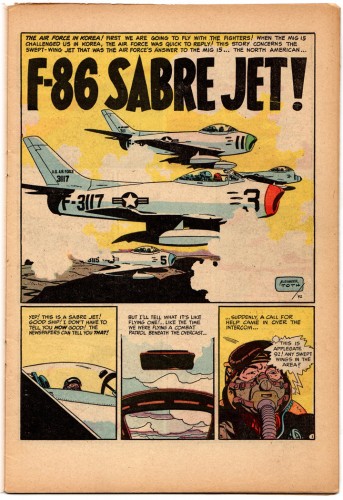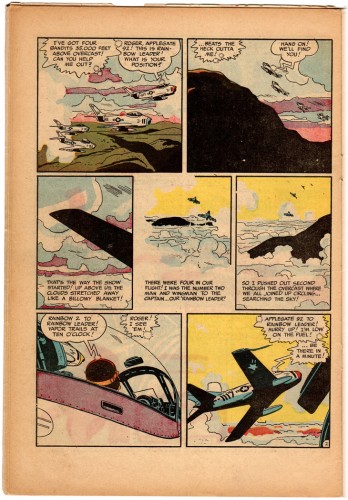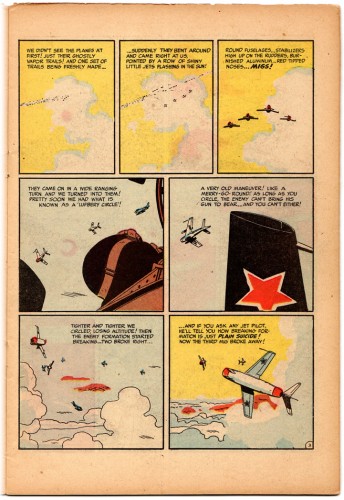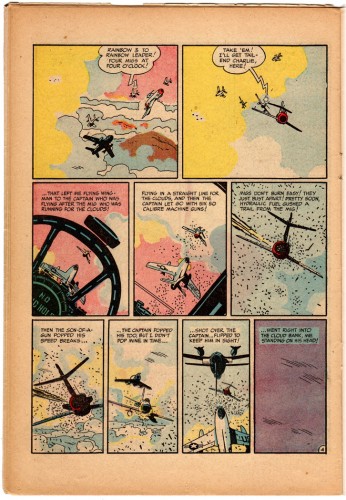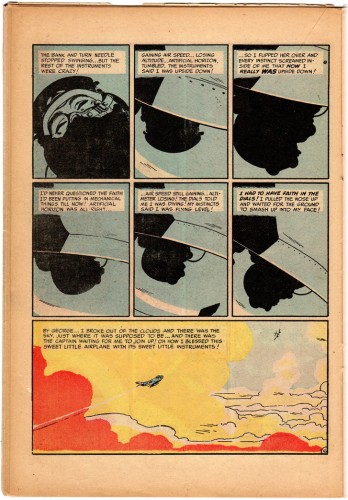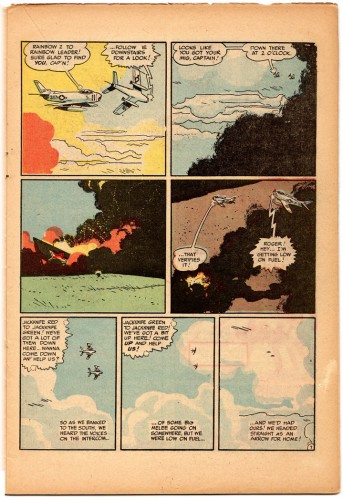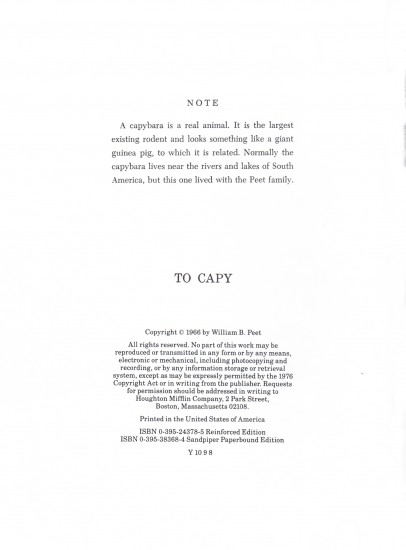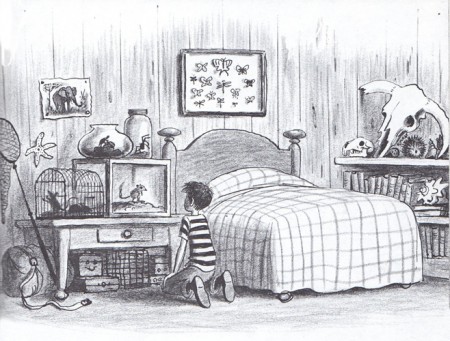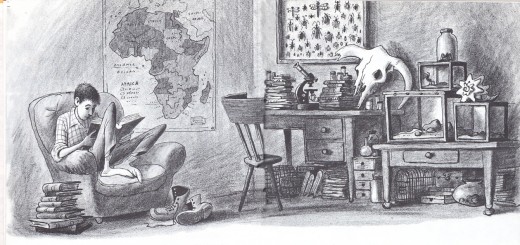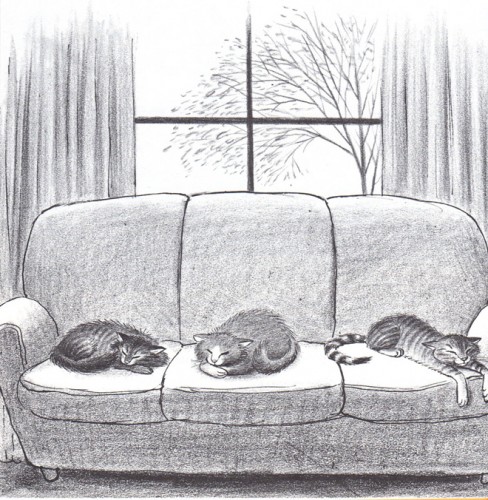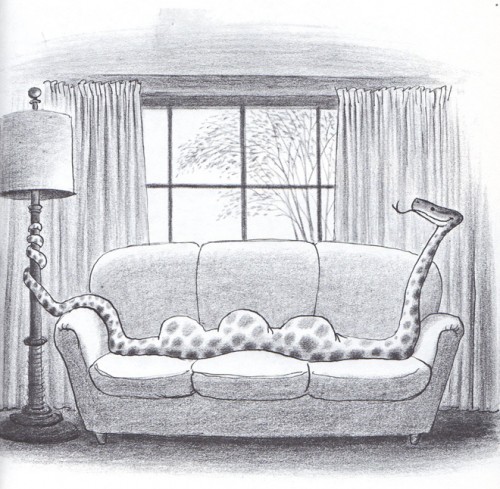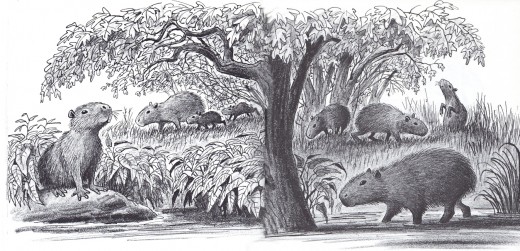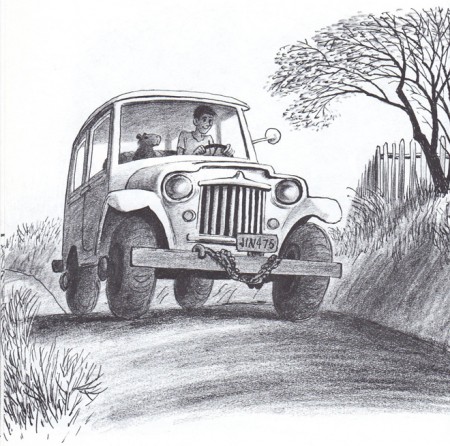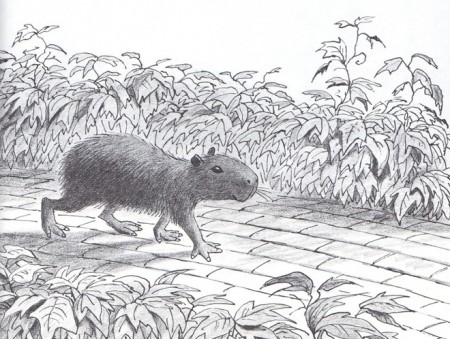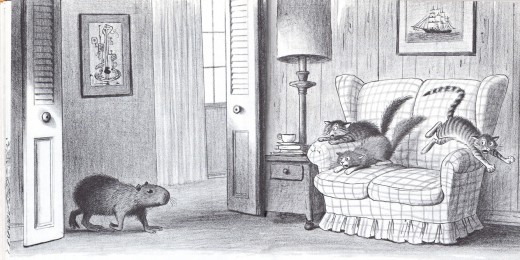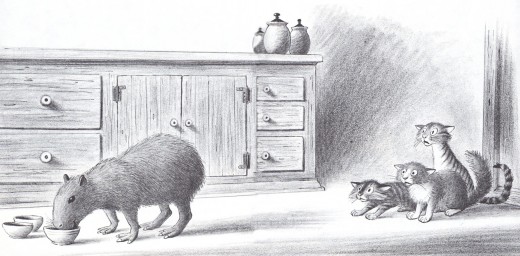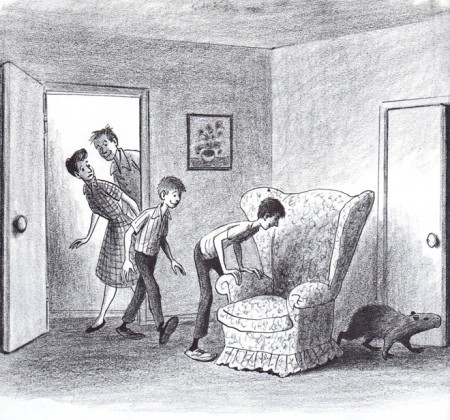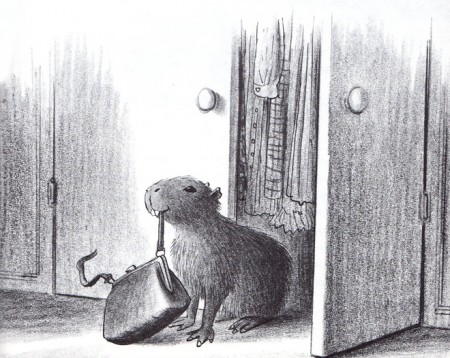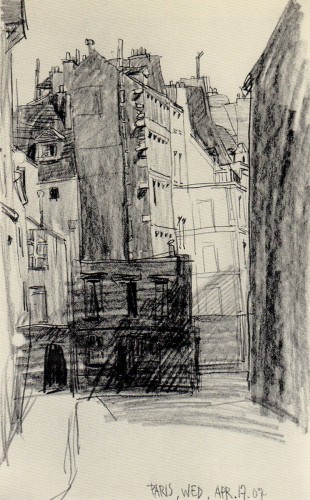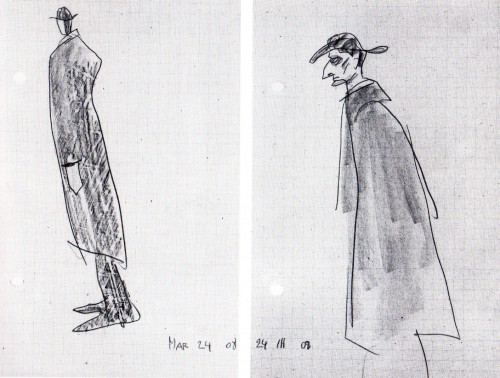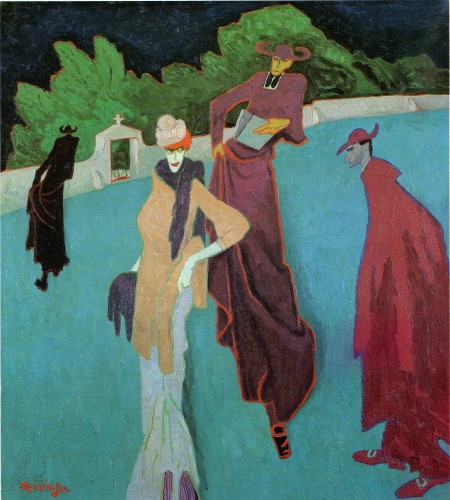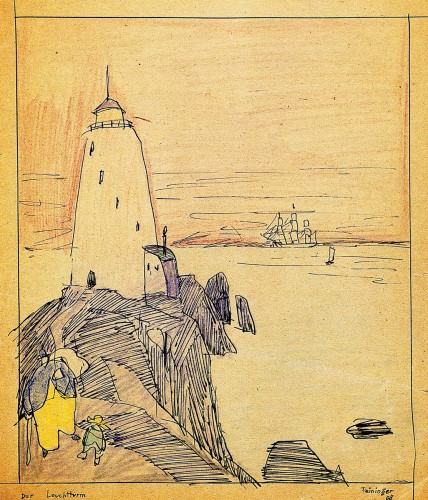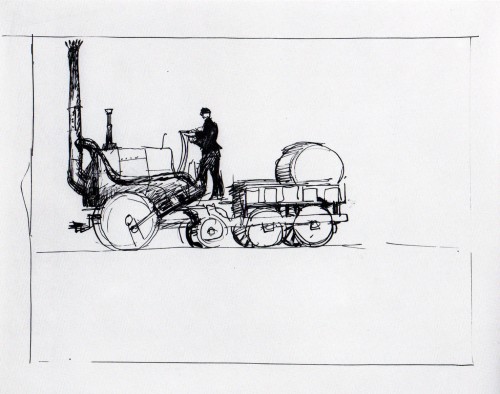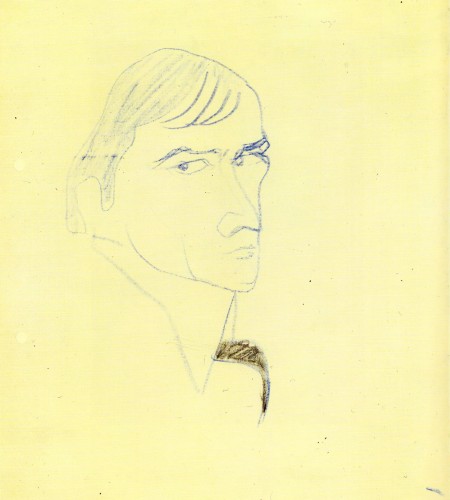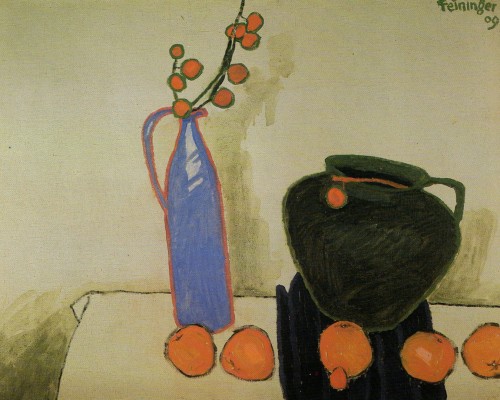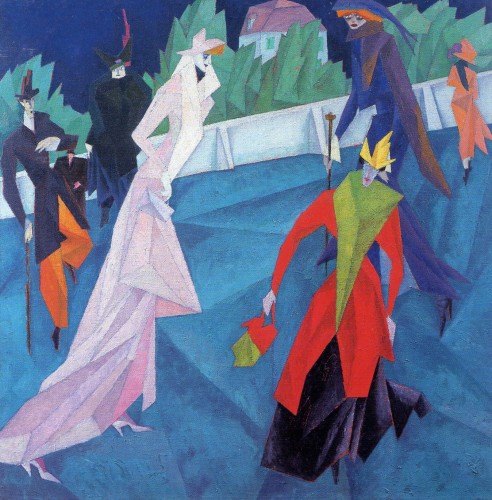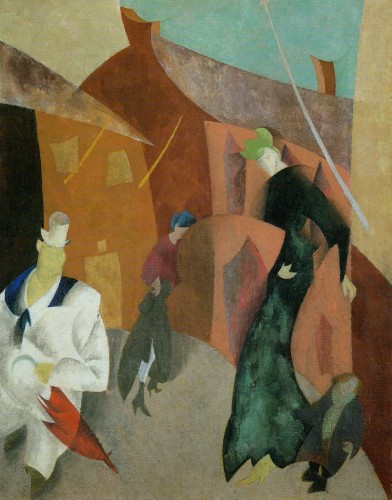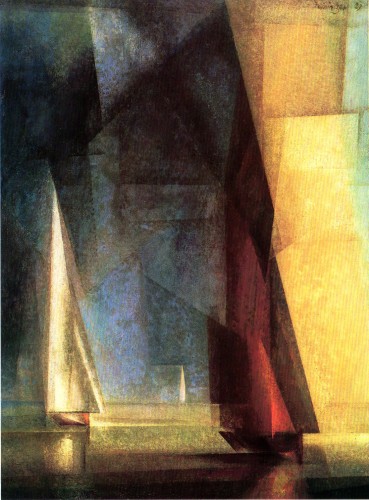Category ArchiveBill Peckmann
Bill Peckmann &Books &Daily post &Peet 01 Apr 2011 07:32 am
Peet Sampler – 2
- Last week I posted samples from half of the Bill Peet books in Bill Peckmann‘s collection. Here, I give you a sampler of the other half. They add up to 26 books. Not bad considering 34 of them were published by Peet. This puts him just behind Maurice Sendak and Dr. Seuss as the third most prolific American children’s book author/illustrator.
As with the other Peet postings, I’ve eliminated the text from the illustrations. I hope this will encourage many of you to buy some of these books. Personally, I’d start with Bill Peet: An Autobiography.
Many thanks to Bill Peckmann, of course, for sharing.
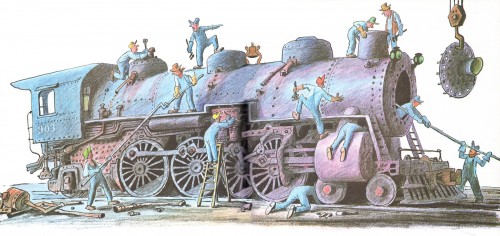 14
14The Caboose Who Got Loose – 1971
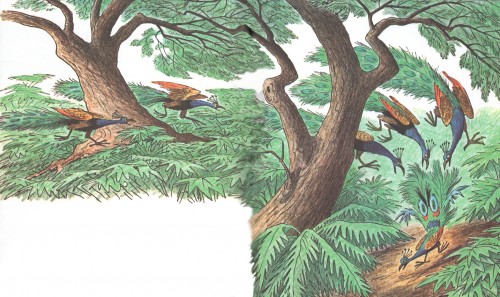 15
15
The Spooky Tail of Prewitt Peacock – 1973
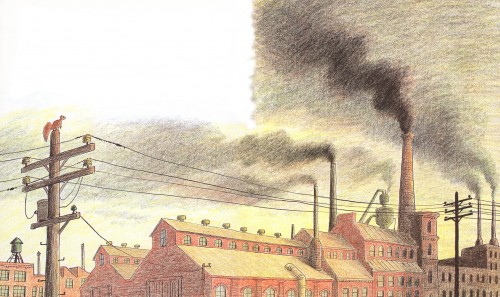 16
16
Merle the High Flying Squirrel – 1974
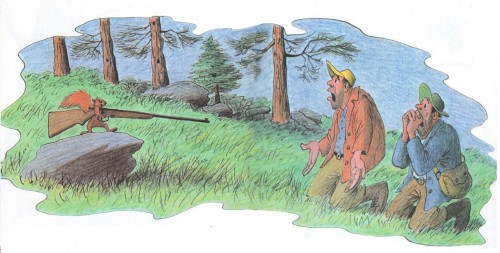 17
17
The Gnats of Knotty Pine” – 1975
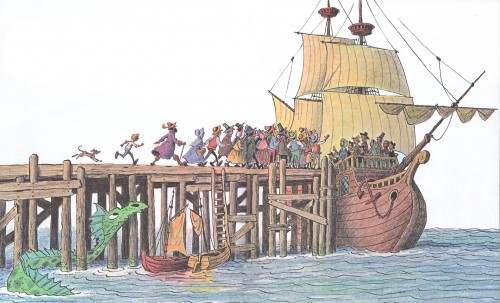 18
18
Cyrus the Unsinkable Sea Serpent – 1975
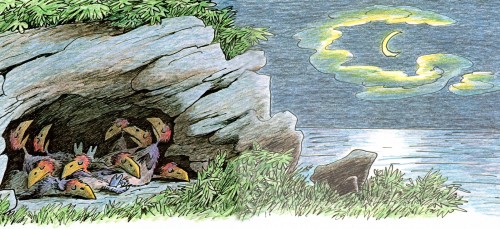 24
24
The Kweeks of Kookatumdee – 1985
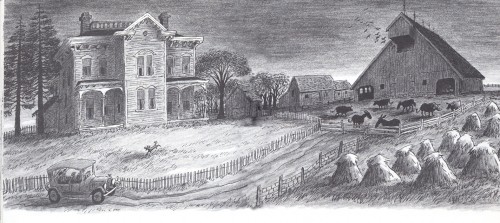 25
25
Bill Peet – An Autobiography – 1989 #1
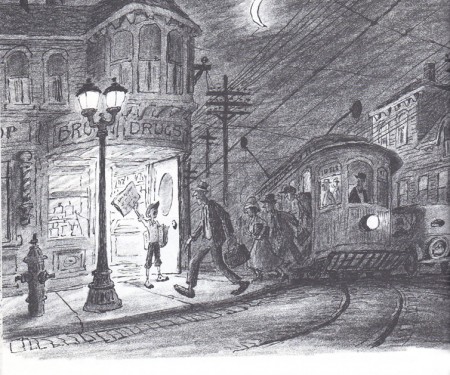
Bill Peet – An Autobiography – 1989 #2
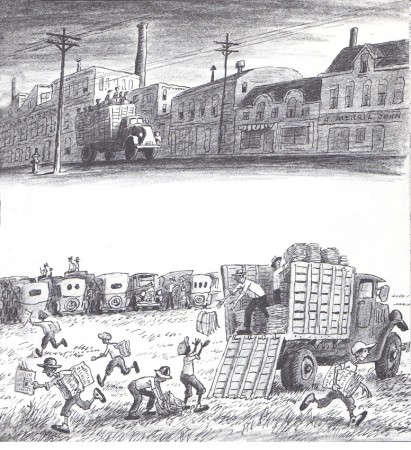
Bill Peet – An Autobiography – 1989 #3
Bill Peckmann &Comic Art &Illustration 31 Mar 2011 07:14 am
Big Bang Busters
- The other day I received this note from Bill Peckmann:
- Before there were Underground cartoonists and comic books in the ’60′s and ’70′s, there was Harvey Kurtzman and Basil Wolverton doing filler features in comic books in the late ’40′s and early ’50′s. Harvey’s “Pot Shot Pete” ran in western comic books and so did Wolverton’s “Bing Bang Buster”. “Buster” ran in a western series titled “Black Diamond Western”. The first installment was in issue # 16, Nov. 1949. Like Harvey’s very distinct style, Basil’s could also be easily spotted at twenty paces. Like “Pot Shot”, “Buster” would be very at home in the pages of an early “Mad” comic book. Wolverton did join the ranks of “Mad” artists in later issues of the comic book. This is one of many features and characters that Basil did in his lifetime but it’s one that usually falls through the cracks.
I’m including the covers of the comic to give the feature a time and place. These were done by Charles Biro who later wound up at the NBC TV graphics dept. I used to see him at 841 u-nion meetings and never made the connection he was the same Charlie of comic book fame, too bad.)
Without further ado, here are a couple of issues:
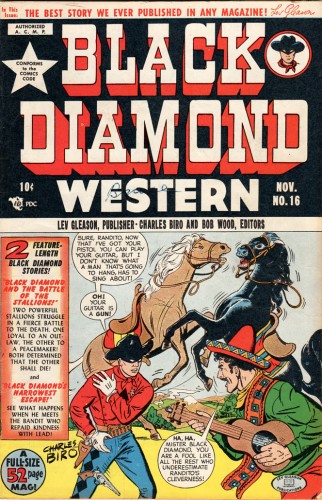
Cover 1
Bill Peckmann &Books &Illustration 29 Mar 2011 07:36 am
The Unidentified Flying Elephant – pt. 1
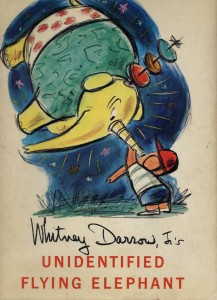 - Whitney Darrow Jr. has been one of the foremost gag cartoonists of our time. His work has appeared in The New Yorker magazine for over 50 years. His first cartoon appeared March 18, 1933 and produced of 1500 cartoons for them prior to his death on Aug. 112, 1999, just shy of his nintieth birthday. He was one of the cartoonists who wrote his own captions.
- Whitney Darrow Jr. has been one of the foremost gag cartoonists of our time. His work has appeared in The New Yorker magazine for over 50 years. His first cartoon appeared March 18, 1933 and produced of 1500 cartoons for them prior to his death on Aug. 112, 1999, just shy of his nintieth birthday. He was one of the cartoonists who wrote his own captions.
Bill Peckmann sent me scans of Darrow’s chldren’s book, The Unidentified Flying Elephant. The drawings are crisp and strong, done in the same wonderful style as his gag cartoons. Although, here, he is workng with color. Robert Kraus wrote the text. (Whitney Darrow Jr. has a large collection of books he illustrated usually partnering with another author.)
The following is the first half of the book:
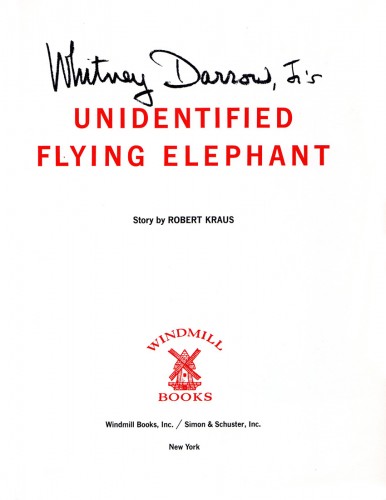 1
1
Many thanks to Bill Peckmann for the material to display.
Bill Peckmann &Books &Illustration &Peet 25 Mar 2011 07:41 am
Peet Sampler – 1
- Bill Peckmann owns 26 of the children’s books by Bill Peet. We’re coming to the finish of posting his beautiful book, Capyboppy, and we thought as a follow-up it’d be best to post a sampler from each of these 26 books. We’ve taken a double page spread from each that Bill has scanned and forwarded to me. I’ve done my best in photoshop to link the two together.
Here, in chronological order, are the first 13 of the books in Bill’s collection. By putting them in order, we can see the development and growth of his illustration style.
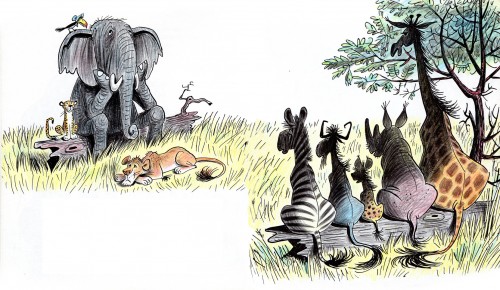
“Hubert’s Hair-Raising Adventure” – 1959
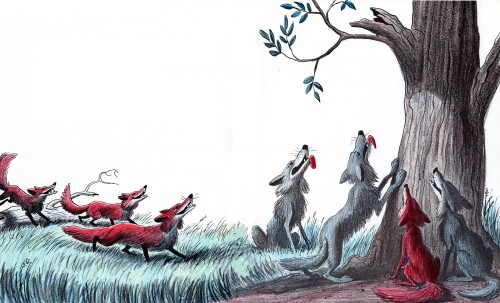
“The Pinkish, Purplish, Bluish Egg” – 1963
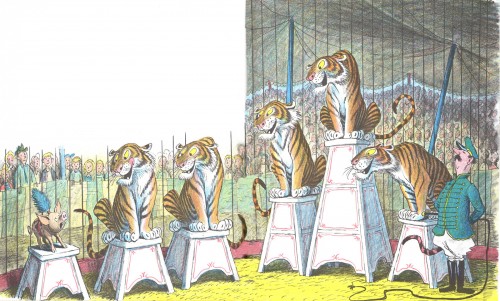
“Chester, the Worldly Pig” – 1965
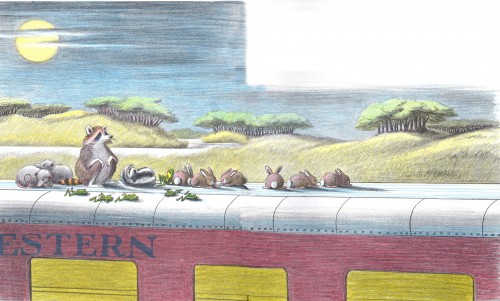
“Farewell to Shady Glade” – 1966
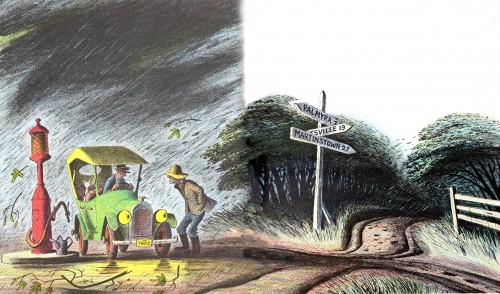
“Jennifer and Josephine” – 1967
Bill Peckmann &Books &Peet 22 Mar 2011 07:48 am
Peet’s Capyboppy – Part 3
- Continuing my posting the fine illustrations by Bill Peet for his book, Capyboppy we go to the third part. As I’ve written with the first two parts, I’m not including Bill Peet’s text; I prefer just to focus on his illustrations. However, I do synthesize the story so that the illustrations make sense.
So, here are those illustrations which Bill Peckmann scanned from his copy of the book:
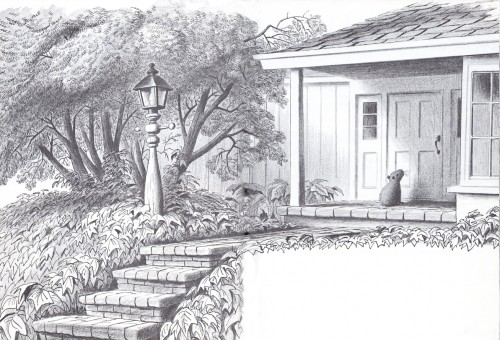 1
1Capy sat on the front porch waiting for us to let him in.
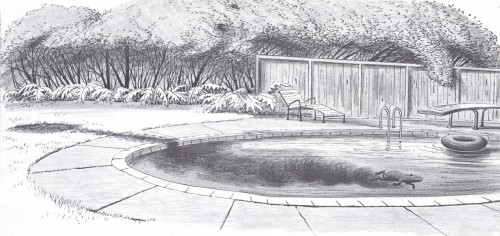 2
2
He got into the habit of rolling in the mud and
getting into the pool to clean off. This made
the pool a dirty brown color. We solved this
problem by putting an old inner tube onto the
mudwallow, which Capy grew interested in.
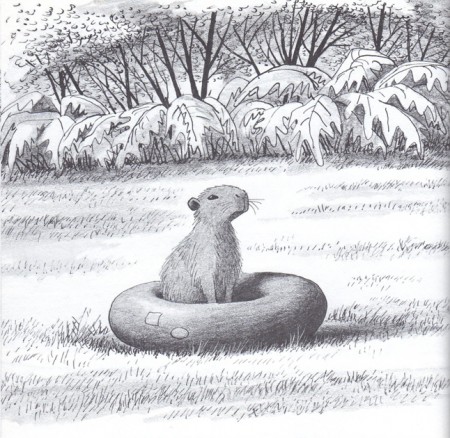 3
3
Capy settled into the inner tube and was irritated
that he couldn’t get to his mudwallow.
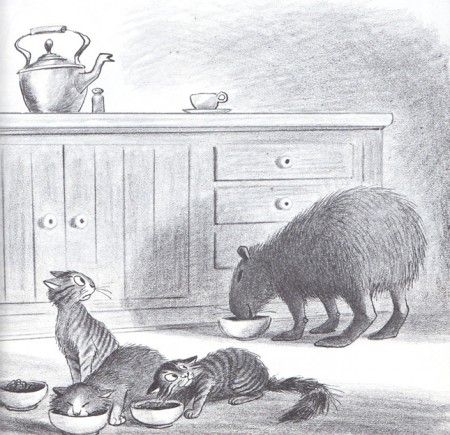 4
4
He was getting to be headstrong.
He ate more and grew bigger.
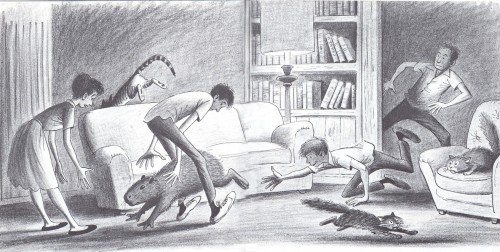 5
5
Capy still rested on the sofa in evenings, however he started to get smart.
When he knew it was bedtime, he’d jump onto the ground and raced down
the hall. Just when we’d cornered him and were about to catch him,
he’d slip our grasp.
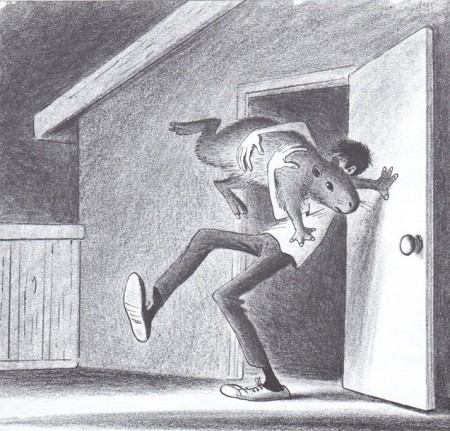 6
6
Even when we caught him, he was a handful
kicking, scratching and tossing about.
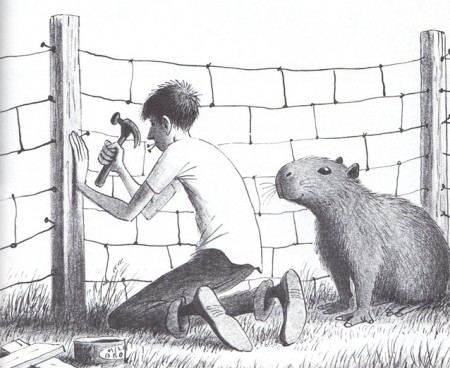 7
7
Bill helped build a pen to safely lace him in, and then
our son left to go on a month-long trip to Mexico.
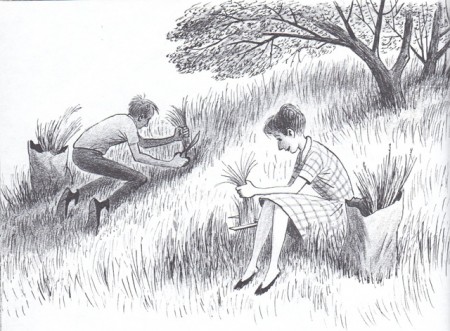 8
8
We used fresh grass that was gathered on the hill
to lure Cappy back into his pen.
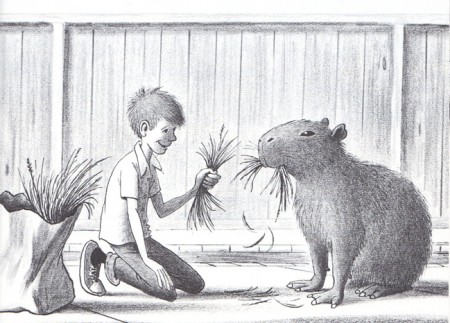 9
9
One day we allowed him to eat more than a handful.
A young friend, Tommy, kept feeding Cappy who finally
jumped at Tommy and scratched him on the head.
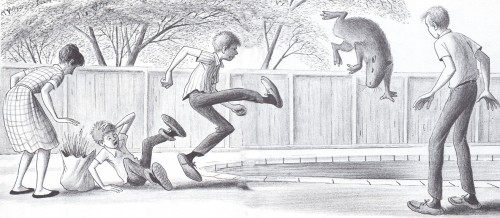 10
10
Tommy screamed and shouted and Capy lept into the pool and
settled on the bottom. Tommy was taken to the hospital and
I went to keep an eye on Cappy.
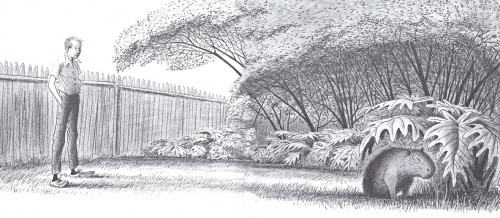 11
11
Cappy had settled in the bushes not moving. I wondered what
had caused his sudden anger, but wondered if it weren’t sudden.
Maybe he’d been building up his resentment of humans. He was a
sensitive animal. Perhaps, in some way he thought he was being
punished. Tommy returned from the hospital and
I turned to find out what news they had.
Again, many thanks to Bill Peckmann for scanning the book.
Bill Peckmann &Comic Art 18 Mar 2011 07:30 am
Kurtzman Kartoons
- Harvey Kurtzman offers a wealth of golden cartoons. Here’s a reprinted selection that Bill Peckmann forwarded to me; I think you’ll enjoy it. Bill wrote:
- This book of Harvey Kurtzman reprints came out in 1976. They are of three “filler” features that HK did for comic books in the late ’40′s. These pre-date the work he did at EC Comics. You can see the early seeds of MAD comics that came a few years later.
His style is timeless, like that of Mary Blair or Bill Peet*. These could have been done yesterday. Love those animated poses. Fortunately he did do a new cover for the book when it came out. There’s also an intro by Robert Crumb.
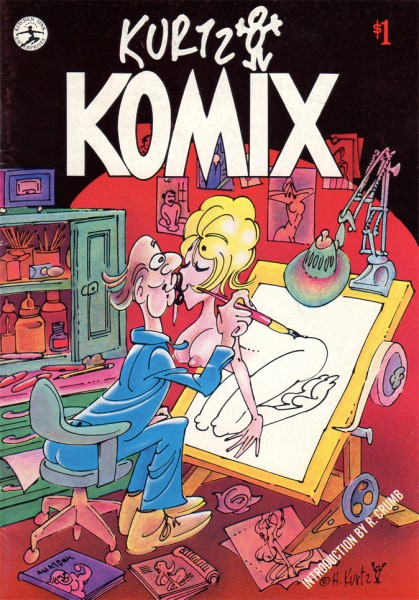 1
1The front cover
Many thanks to Bill Peckmann for sharing.
Bill Peckmann &Illustration &Peet 11 Mar 2011 06:51 am
Peet’s Capyboppy – part 2
- Here I continue posting the fine illustrations by Bill Peet for his book, Capyboppy. I’ve chosen not to put Mr. Peet’s writing in the post, feeling it isn’t quite ethical, so have condensed the story so that the illustrations make sense. I would urge you all to buy a copy of this book for the writing alone.
The book’s about 60 pages in length, so it’ll take a couple of more posts to share the artwork. It’s a gem.
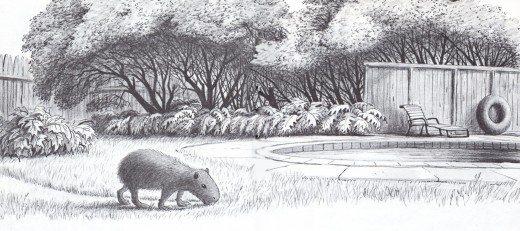
Our new South American visitor couldn’t have been happier in the yard with the swimming pool and the meatly trimmed lawn. At first he enjoyed himself swimming gracefully in the pool, but then it became obvious he needed a playmate.
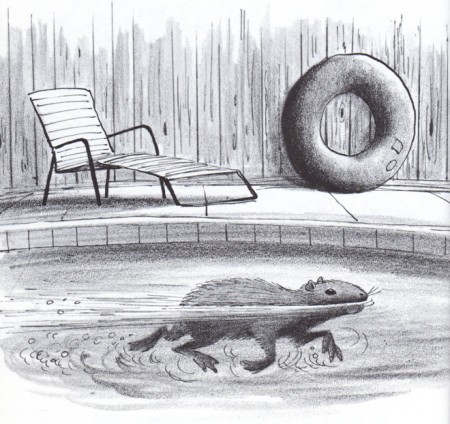 22
22
The family worked during the week, but on weekends there were plenty of visitors to keep Capy occupied. He swam when everyone swam and rested when they did, tweeting his tweets as if to join in on the conversation.
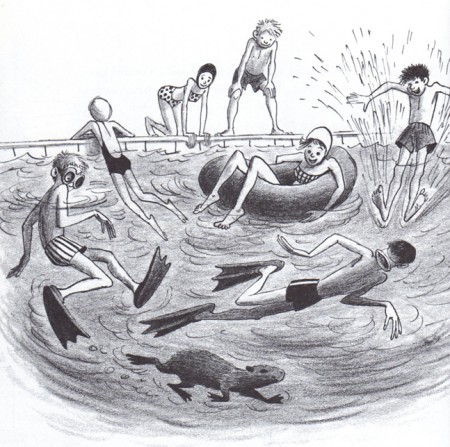 24
24
In the evenings, he joined the family in the family room watching television and sleeping in Margaret’s lap while the cats watched on jealously and miserably. At the end of the evening it was Bill’s job to take Capy out to the garage (kicking and squealing all the way) where he had his bed. He was getting spoiled.
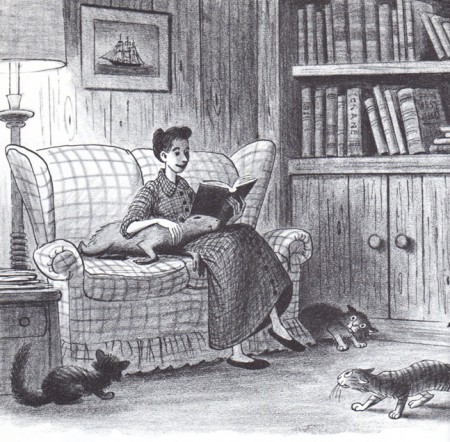 26
26
His day would begin with a warm shower, after which Margaret dried him with a fluffed towel. After this he ate a nice breakfast of barley and oats.
His favorite food was graham crackers, and some days Margaret would scratch his back with the back-scratcher until every one of his hairs stood on end.
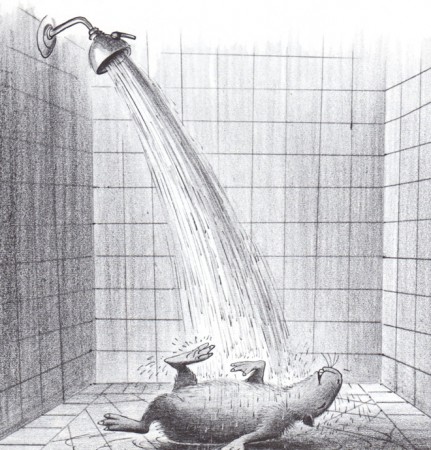 28
28
There were times we’d leave him in the yard too long until he started Tweeting madly to get us to let him in. One day he came inside the studio while I was drawing and I watched him nose about all the books, magazines and art materials. He ate a grease pencil.
I didn’t mind losing a grease pencil, but he started eyeing some drawings on the wall. I couldn’t lose a month’s work if he ate them, so I pushed him out to the stairwell and rudely shut the door behind him.
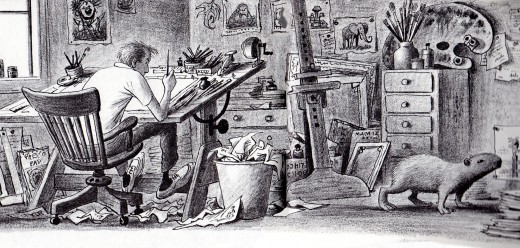
I would check on him from time to time to make sure he was safely within the yard. We had a notice on the gate to make sure it was kept closed. But one day, I saw that the gate had been left open and Capy had escaped.
Margaret and I ran out searching for him calling out “Capyboppy! Capyboppy!” No Tweeting response, so we ran to the car to slowly drive about the neighborhood in search of him. Immediately, after we pulled out of the driveway, Margaret shouted, “There he is! There’s Capy!”
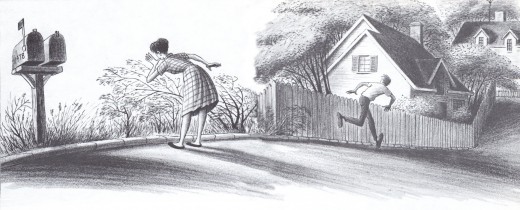
Many thanks to Bill Peckmann for scanning and sharing this art with me for the blog.
Bill Peckmann &Comic Art &Illustration &T.Hachtman 08 Mar 2011 09:15 am
Frontline Comics
- This is the comic book FRONTLINE COMBAT (#12). It was sent to me by Bill Peckmann, and he best delineates what makes this issue so important. In Bill’s words:
- Here’s the worn, torn cover and imperfect pages* of FRONTLINE COMBAT (#12) comic book from 1953.
Harvey Kurtzman (Age 29) – Editor, writer and lay-out artist.
Jack Davis (Age 29) – Cover (Before he was famous for his TV Guide & Time covers.) and one story.
Alex Toth (Age 25) – One story.
It doesn’t get much better than this. Would be hard to find a bunch of comic book artists from this time period who could do a better job at setting mood, time and place. And, look at those ages, WOW… them, there young whipper snappers!
Alex’s graphic design of those pages is a wonder. At that period in his early career the story is really something to behold. He and Harvey battled (neither one had pleasant memories of this) over how this story should be done/told and unfortunately they never worked together again. If you look at AT’s other aviation stories (not done with Harvey) at this time, they’re good, but do not reach the level of great art that “F-86″ breached. So, even though they couldn’t/didn’t agree, without their collaboration, we would never have had this keeper of a story!
-Bill
ps: Pages are a little off register and some of the ink bleeds through from the other side of the page but there’s still a wonderful softness that’s there, kinda like 4 strip Technicolor movies.
I couldn’t agree more. Here’re the scans:
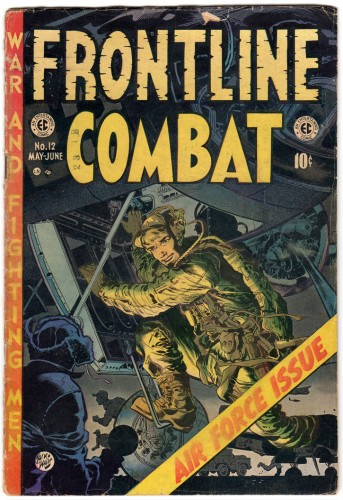 1
1
It just so happens that I received an email from Tom Hachtman today, and I thought I’d post it here since it’s somewhat appropriate:
- I just got a copy of ‘The Art of Harvey Kurtzman’ – because I am an artist and a humorist and not much of a musician I find Harvey more important than the Beatles and Harry Shearer, in an intro, says, ‘…no Harvey no Simpsons’ and ‘no Harvey no SNL’.
I’d like to add ‘ no Blazing Saddles or Young Frankenstein’ and probably no David Letterman – hard to say – ALSO – I think it is in ‘A Hard Day’s Night’ that there is a scene where John Lennon is reading a MAD paperback and those were all Harvey – so, maybe NO HARVEY NO BEATLES haha – and I think it was George at a press conference when they arrived in the USA, when asked what they call their haircut responded, ‘Arthur!’ – ‘Arthur’ was the name of the potted plant mascot that often appeared in the early MAD.
And of course ‘no Harvey no Crumb’ and if no Crumb – well, “NO HARVEY NO ME?”
I guess I am trying to say, “Thank you Harvey!”
Yet again, many thanks to Bill Peckmann for this treasure.
Bill Peckmann &Books 04 Mar 2011 08:15 am
Peet’s Capyboppy – 1
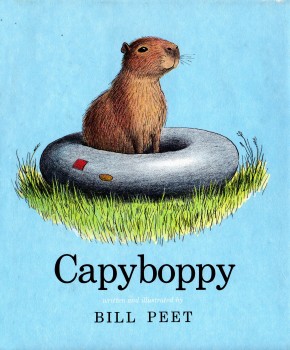 - Bill Peckmann has been sending scans of Bill Peet’s book, Capyboppy. This is about a 60 page book which includes a lot of B&W illustrations.
- Bill Peckmann has been sending scans of Bill Peet’s book, Capyboppy. This is about a 60 page book which includes a lot of B&W illustrations.
I don’t think it particuly ethical to post the illustrations AND the writing. Consequently, I’ve decided to post the illustrations as stand-alone without the text.
Since the illustrations don’t make much sense without the story, I’m adding a short synopsis as we go. I encourage you, if you like it, to get the book. It’s a gem. you can buy a paperback copy from Amazon for very little money.
The book has a similar feel to Bill Peet An Autobiography, one of the best books of its kind around. I must have read that book about a dozen times since buying it years ago. Prior to publishing this book, Peet wouldn’t reveal his connection to the Disney studio in his encapsulated bios found on the back flyleaf of his children’s books. He wanted a separation from the studio and got it.
The man was a genius who brought so much to the films he worked on, yet tried to separate himself from that work.
Here’s the first part of Capyboppy:
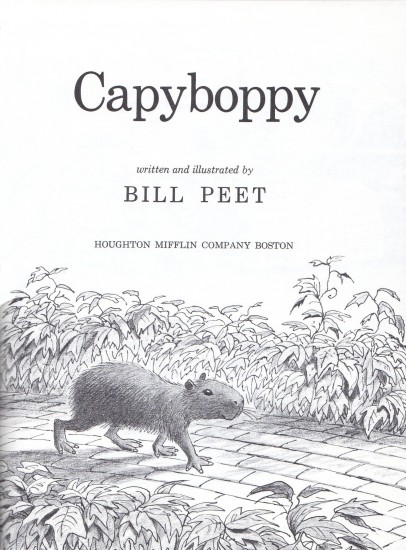 3
3
This story tells of the author’s son, Bill. Bill collected wild animals:
tarantulas, mantises. lizards, the like. Usually, one would replace another
as Bill grew older. When he moved off to college, Bill wanted a boa, but
the family was afraid of the boa escaping and eating the three pet cats.
Bill agreed not to get a boa but asked if it were all right to get a capybara.
A capybara is the world’s largest rodent sometimes getting up to 200 pounds in weight.
It was agreed and Bill placed the order. When it arrived, Bill drove it up to the door
in his jeep. The capybara jumped out and waddled into the house making sounds like
a bird, “tweedle-tweet.” This aroused the curiosity of the three cats, but when they
saw the big fella, the cats all jumped and ran.
The capybara ignored them and went straight to the kitchen and
ate their food. One would expect the vegetarian rodent to turn is
nose away from the cat food, but he ate all three bowls worth.
He was just five months old now, what would he be like when he grew?
After eating the cat food as well as some oats and barley he roamed about the house
with the family following. “Tweedle-tweet.” As he went about the house, he was
not just investigating. He’d take a bite out of everything.
The family decided to move him to the back yard.
To be continued.
Many thanks to Bill Peckmann for sharing this great work.
Art Art &Bill Peckmann &Books 03 Mar 2011 08:10 am
Feininger – 6
- More “Art” from Lyonel Feininger. These illustrations are culled from three separate show catalogs that Bill Peckmann has saved. We’re fortunate he’s sharing them with us. Thank you, Bill.
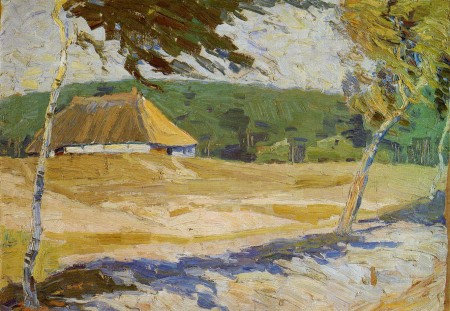 1
11907 – Road, Autumn Wind
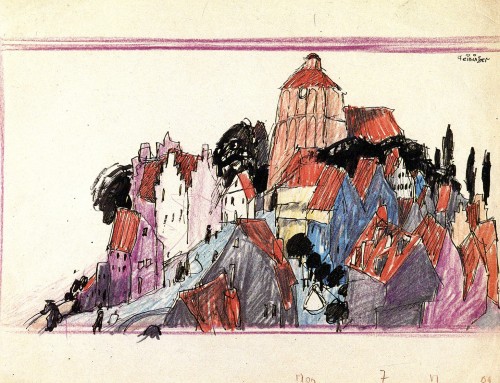 9
9
1909 – Church Above the Town
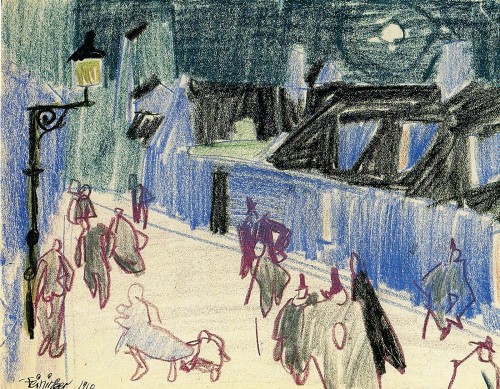 11
11
1910 – Study for Street, Dusk
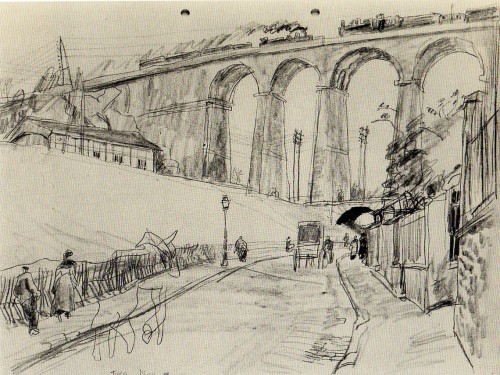 12
12
1911 – Viaduct Near Meudon with Two Trains
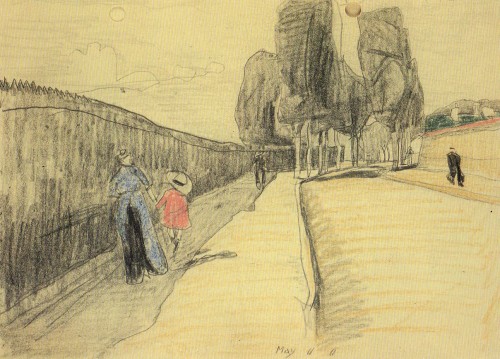 13
13
Suburban Street with Figures
